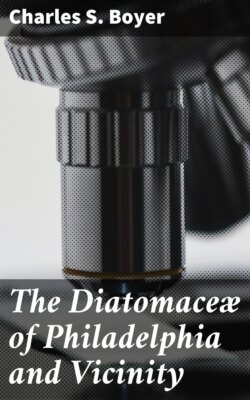Читать книгу The Diatomaceæ of Philadelphia and Vicinity - Charles S. Boyer - Страница 21
На сайте Литреса книга снята с продажи.
Hyalodiscus Ehr. (1845)
Оглавление(hyalos, transparent, and discus, a disc)
Frustules spheroidal; valve with a flattened, irregularly punctate umbilicus from which proceed radiating or decussating lines of fine puncta.
ANALYSIS OF SPECIES
| Valves divided into sectors | stelliger |
| Valves not divided but interrupted by short dark lines at intervals | radiatus |
| Valves with very fine puncta | scoticus |
HYALODISCUS STELLIGER BAIL.
Valve with puncta in oblique decussating rows which, by reason of the difference in obliquity, form numerous sectors. Umbilicus irregular, with scattered, coarse puncta. Margin wide, striated.
Podosira maculata Wm. Sm.
Blue clay. Not common.
Pl. 1, Fig. 22.
HYALODISCUS RADIATUS VAR. ARCTICA GRUN.
Valve with radiating puncta from a rather small umbilicus, the rays interspersed with short, dark lines, having the appearance of spines, at irregular intervals. Margin broad, striated.
Pyxidicula radiata O'Meara.
The Philadelphia form corresponds exactly to Grunow's variety which has closer puncta than the type form.
Blue clay. Rather rare.
Pl. 1, Fig. 21.
HYALODISCUS SCOTICUS (KUETZ.) GRUN.
Valve small, with puncta about 24 in 10 µ, appearing hyaline.
De Toni remarks that it resembles a small form of H. subtilis which occurs north and south of our limits and is yet likely to be recorded.
Cyclotella scotica Kuetz.
Podosira hormoides Wm. Sm.
Blue clay. Not rare.
Pl. 1, Fig. 20.
Endochrome in the form of four flaps or patches bound together about a common pyrenoid. In H. subtilis numerous rod-shaped chromatophores lie in a row and are not bound in the centre (Mereschkowsky).
